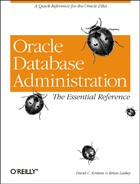 Families of Views
by Brian Laskey, David C. Kreines
Oracle Database Administration: The Essential Refe
Families of Views
by Brian Laskey, David C. Kreines
Oracle Database Administration: The Essential Refe
- Dedication
- Preface
- I. DBA Tasks
- 1. Introduction
- 2. Installation
- 3. Maximizing Oracle Performance
- 4. Preventing Data Loss
- 5. Oracle Networking
- Oracle Names
- MultiProtocol Interchange
- Connecting to Non-Oracle Databases
- Network Manager Data Storage
- Using Network Manager
- Files Created by Network Manager
- Oracle Net8 Assistant
- Manual Network Configuration
- Sample SQL*Net Files
- SQL*Net Troubleshooting
- 6. Security and Monitoring
- 7. Auditing
- 8. Query Optimization
- 9. Oracle Tools
- 10. The Oracle Instance
- 11. The Oracle Database
- 12. Initialization Parameters
- 13. SQL Statements for the DBA
- SQL Commands by Task
- SQL Command Syntax
- Reference Section
- Reference Section
- Reference Section
- Reference Section
- Reference Section
- Reference Section
- Reference Section
- Reference Section
- Reference Section
- Reference Section
- Reference Section
- Reference Section
- Reference Section
- Reference Section
- Reference Section
- Reference Section
- Reference Section
- Reference Section
- Reference Section
- Reference Section
- column_constraint_clause
- auto_extend_clause
- for_clause
- filespec
- autoextend_clause
- global_index_clause
- local_index_clause
- table_constraint_clause
- table_ref_clause
- column_ref_clause
- column_constraint_clause
- index_organization_clause
- segment_attrib_clause
- partition_clause
- autoextend_clause
- 14. The Oracle Data Dictionary
- Static Data Dictionary Views
- Dynamic Performance Data Dictionary Views
- 15. System Privileges and Initial Roles
- 16. Tools and Utilities
Families of Views
Most of the data dictionary is constructed in a matrix fashion. The first way to categorize data dictionary views is by the breadth of information they cover. Views can be divided into four groups:
Views that allow you to see objects you own. Most of these views begin with USER_.
Views that allow you to see objects that you own or that were granted to you. Most of these views begin with ALL_.
Views that allow you to see all objects in the database. These are primarily for use by the DBA. Most of these views begin with DBA_.
A handful of other views that provide information of general interest about the database.
The second way to categorize data dictionary views is by content. Many of the USER_, ALL_, and DBA_ views are grouped in families, according to how their view names end (e.g., TABLES, COLUMNS, and so on). Groups of views provide information about various topics, including:
Tables
Storage
Columns
Views
Objects
Networking objects
As this is a book for DBAs, in this chapter we’ll concentrate on the DBA_ views and the other views of interest to DBAs. The ALL_ views have the same structure as the DBA_ views. The USER_ views have the same structure as the DBA_ views with the exception that they do not include the OWNER column.
-
No Comment